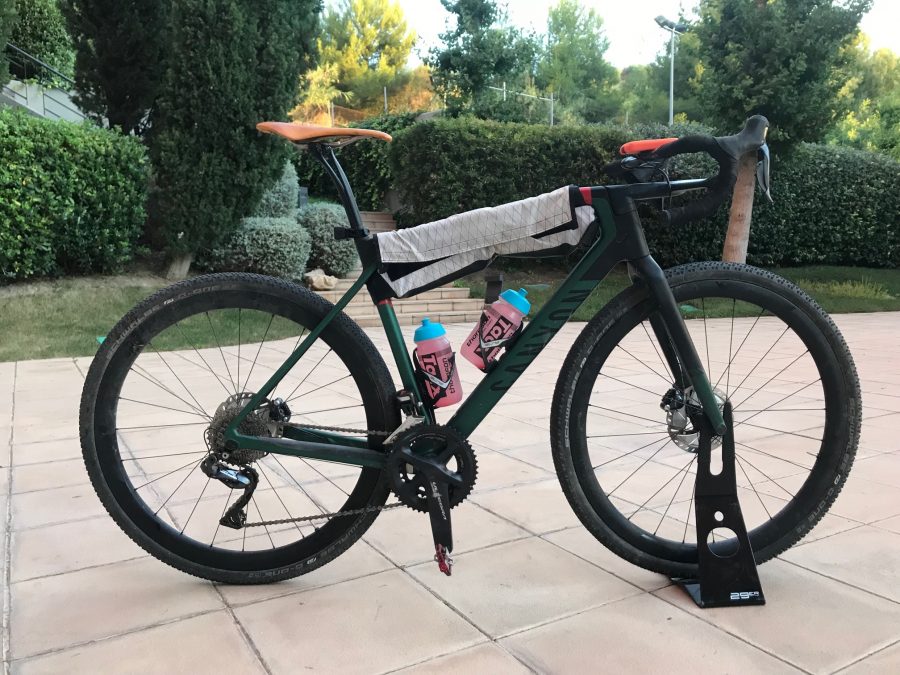I’ve been fortunate to test the Canyon Grail for a week, riding from Barcelona to Girona with Thomson Bike Tours. The routes they have designed have been excellent for testing this bike, with a mix of pavement (about 30%) and a broad spectrum of gravel roads and singletrack. Canyon is Thomson’s bike supplier for rentals, and I jumped at the chance for the trip as well as the opportunity to test the bike. Judging by the Canyon website, the bike I am riding is a 2019 with a nice black and green colorway.
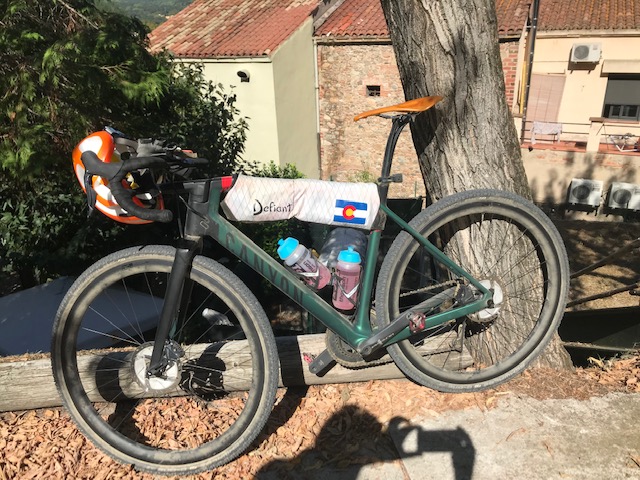
I’m riding the version with Ultegra Di2, Reynolds tubeless carbon wheels, Schwalbe G-One Bite tires, and the split seatpost. This bike burst onto the internet in the spring of 2018, and its biplane handlebar instantly set the cognoscenti into fits of self-righteous rage at the horror of witnessing design creativity in the cycling industry. Oh, the humanity.
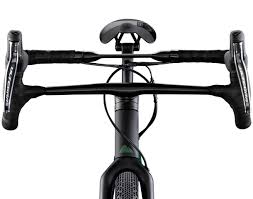
Let’s address the elephant in the room first: the handlebar. Canyon calls this contraption the “Hover Bar”. My Spanish guide calls it the “Hoover Bar”, which made me think of a place where vacuum cleaners hang out after work.
The handlebar is certainly creative, distinct, and yes, it works- mostly. When riding on the tops, I can’t feel the flex or bounce of the bar (remember, the idea is that the flattened section in the middle is designed to act basically as a leaf spring and allow the tops to move up-and-down as a suspension system).
Actually, that’s a really cool idea. And, I think it works. Maybe. High-speed video from several sources shows it doing its trick, but I couldn’t feel it. I suppose I could say my hands were less fatigued, but in reality, when I’m rattling around on gravel, particularly the rougher stuff, I want my hands closer to the brakes, where the bar is rock-solid. It works well on flat roads where you don’t need to touch the brakes, particularly on washboards. That being said, I try to avoid washboards.
But, let’s give credit where credit is due: Canyon’s designers may well have hit on a fantastic idea. However, the devil is in the details, or so I have been told. The Shimano Ultegra shifter bodies have cast plastic bodies, and they are designed to be on internet-approved standard handlebars. The inboard edges of the shifter bodies have castings that allow cable housings to leave and follow the curve of the bars.
In the case of the Grail handlebar, I could feel the cable exits create bumps in the rubber hoods, just inside your thumbs when you ride on the hoods. So, depending on the size of your hands and your grip, this may be an issue. It doesn’t bother me per se, but I am aware of it, so maybe it does.

The lower “wing” of the bar is where it actually gets its structure, and this connects to the the bar assembly inside the apex of the bar curve. The result is that when you are in the drops, your thumb hooks over the top of this bar (which is taped for about 2”). The upshot is that your thumb goes over the top, in a sort of pistol grip. This actually works pretty well, at least until it doesn’t. If you try to climb Pantani-style, out of the saddle and hands in the drops, it’s pretty uncomfortable, causing a kink in the wrists.
Again, the size of your hand and grip will have a huge affect on the success for this bar for you. I find that for the most part, it fits my hands OK, but in some cases, continuous impacts such as a rough road, make the inside web of my thumb and knuckles hurt.
The final aspect of the bar that must be addressed is the proprietary stem and bar assembly. You get one size. If it doesn’t fit, too bad. The bar and stem combo does scale, so the 2XS has a 60mm stem with 400mm width bars, and the 2XL has a 105mm stem with 460mm bars. My medium has a 70mm stem and 440 bars. Presumably you could order a swap-out with the bike; I don’t know.
Attaching a computer requires purchasing an additional mount that installs under the lower, structural bar. I simply used the Garmin mount with the rubber bands and put it on the leaf-spring center section of the upper bar. This was far from ideal, but functional. The shape of both layers of the handlebar means a mount from K-Edge, BarFly, or Garmin is out of the question.
Beyond the much-discussed bars, there’s actually a bike under them. The geometry is quasi-standard for gravel, although I think the 72.5* head tube angle reads a bit steep for a medium. However, with 425 chainstays and a 1029mm wheelbase, the front center is long enough that it tracks very well. Canyon doesn’t publish fork rake, so I can’t derive the trail, but it’s on the long side, resulting in somewhat slow but very predictable steering.
The split seatpost design appeared a couple of years ago as an aftermarket part, and I was interested in trying it out, but never had the chance. The post is a 2-piece design with a binder bolt at the bottom to adjust pitch. The idea is that the 2 halves flex like a leaf-spring, and unlike the HoverBar, I was able to feel this in action. It definitely absorbs small bumps and chatter, and feels about exactly like my own 27.2mm titanium seatposts. I like the ti posts for their bump-absorbing characteristics, and this post felt the same. It’s expensive: a $250 adder, so priced about the same as a Moots or Eriksen post (and about 3 times as much as a Chinese eBay post). Still, the design is good, and it (or its titanium cousin) will definitely save your ass on a gravel ride.
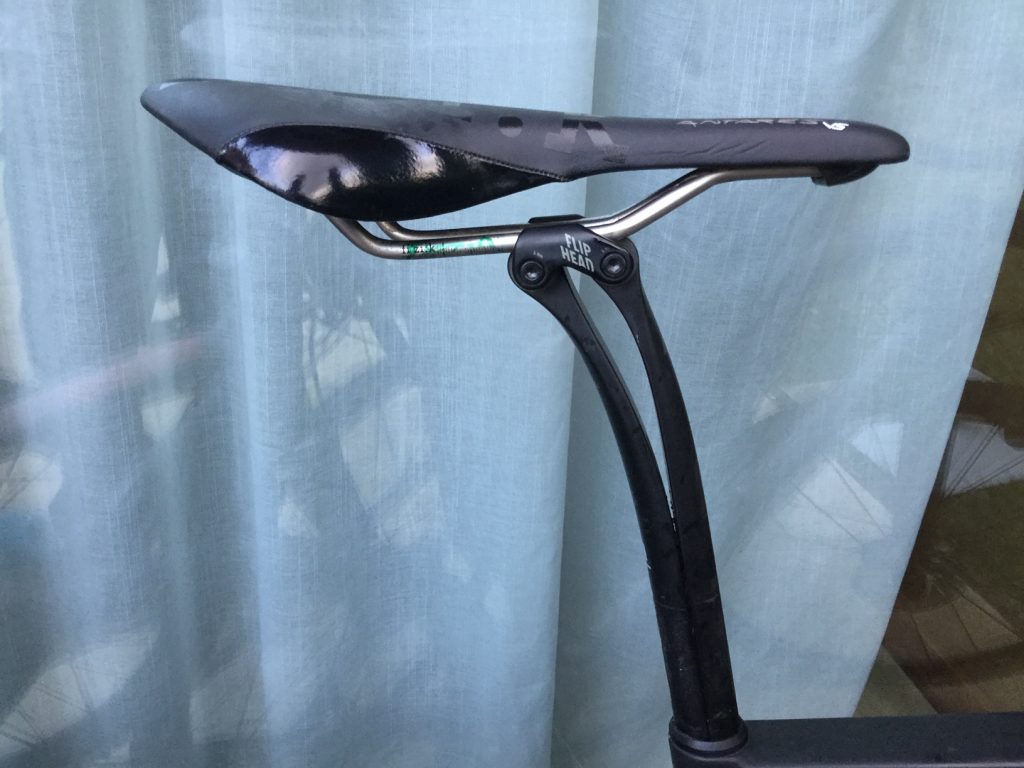
On fireroads, the bike holds its line well, and doesn’t get deflected easily by runnels, rocks, roots, small dogs, or pedestrians under about 5’6”. I rode some singletrack, but it wasn’t twisty enough to test the bike in tight turns. My sense it that it would maintain its predictability and be fine.
Climbing, the bike seems to prefer you to stay in the saddle to maintain rear tire contact and grip. Singlespeeders know that there are different balance points when out of the saddle, and this bike wants you to keep your weight aft while standing to keep the Schwalbe G-One Bite, um, biting.
On steeper grades (above about 15%) and on looser soils, I had to sit on the saddle nose and lean down on the bars to keep the front wheel on the ground. It did have a tendency to lift if I shifted my weight to the center of the saddle. If I had slid to the back to get full leg extension, I would have looped out.
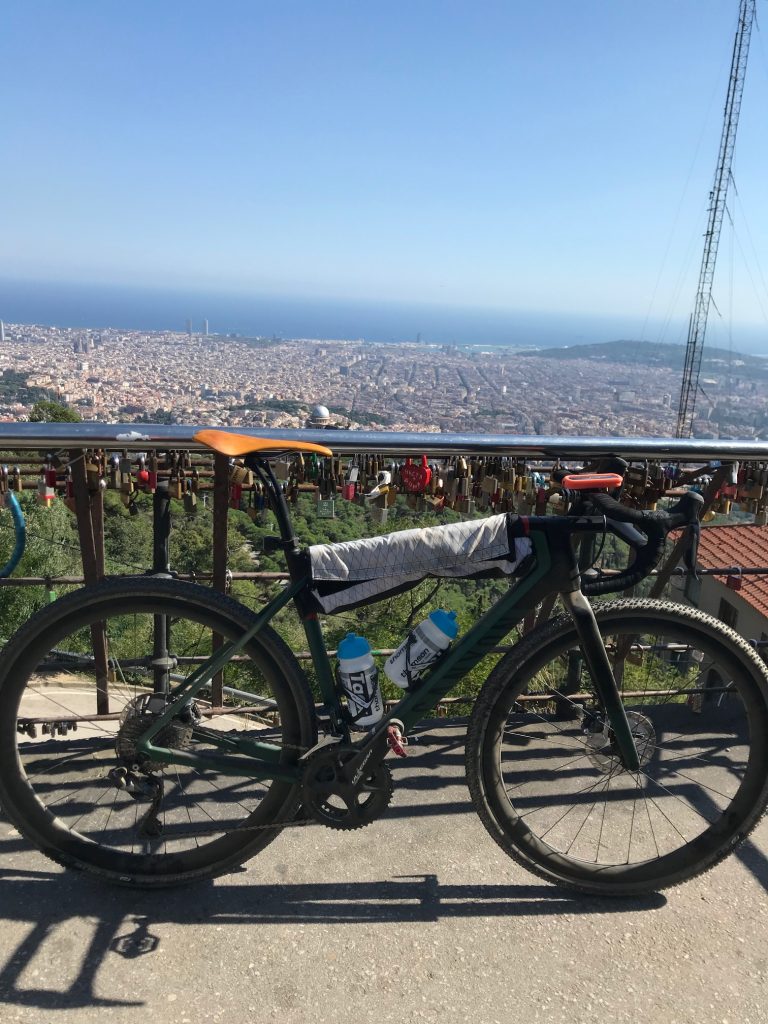
I used my own toptube bag, made by Defiant Packs in Carbondale. Canyon has their own line of packs that fit the bike, and once you go toptube bag, you never go back. It’s just so useful for gravel rides, and given my penchant for flyfishing shirts on the gravel bike, it provides a place for stuff that normall lives in a jersey pocket.
Descending, the bike tracks extremely well and allows you to relax. This is important for your grip while in the drops (see above). The Schwalbe G-One Bite tires are OK. I’m not as impressed as I had hoped to be. I like the Donnelly MSO the best, and have been pleased with tubeless 650b x 48 Panaracer Gravel King SKs. It may be that the pressure in the G-Ones was too high, but lacking a digital gauge I never really bothered to check.
As far as I can tell, the “Bite” part off the G-One is what it does with any soil that has a moisture content higher than 0.01%. We rode through some damp sand, and that stuff clung tenaciously to the tires for several miles. The tire locked on to that material like a pit bull, and only reluctantly self-cleaned once on dry surfaces. On dry soils they have been fine, but are apparently hydrophilic, or at least, mudphyllic.
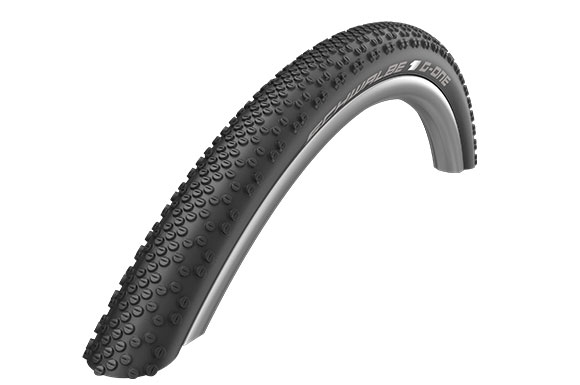
Of the dozen cyclists in our group, I counted 6 guests plus 2 guides riding the Grail with the Reynolds/Schwalbe combo. We have seen more flats on any ride than I can remember, from punctures to cuts to burped rims. Mine held pretty well at about 45 PSI, but then on a relatively chunky rocky section (by gravel bike standards, it wouldn’t have registered on a mountain bike), I burped my rear tire. I pumped it back up, rode it, lost air, repeated. This lasted about a mile before I gave up and put in a tube. I was surprised at how easily the tire came off the rim, and how easily it went on. As in: it’s the only tubeless tire and rim combo I’ve ever worked on without a tire lever. I was able to break the bead with bare hands. I know that I can’t do this on my own bikes.
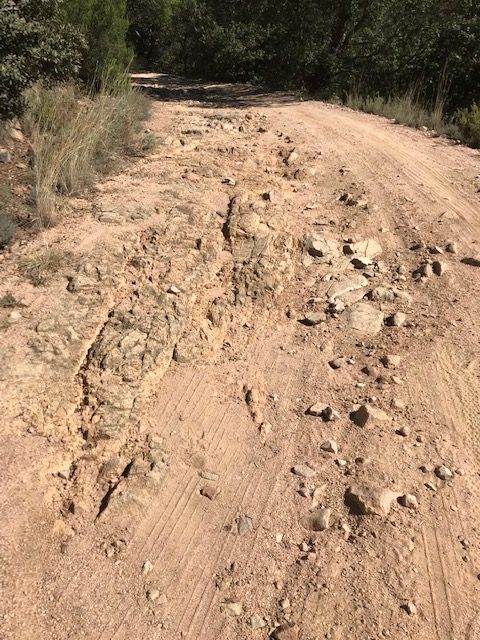
My own tubeless setups are much tighter, and I can’t pull or reseat my tires without levers. The fact that I could do so easily on the trailside may mean that the bead seat isn’t very tight and that may explain why I was able to burp the tire on such mild terrain. In any case, installing a tube meant I didn’t have to walk the 10km to the next van stop.
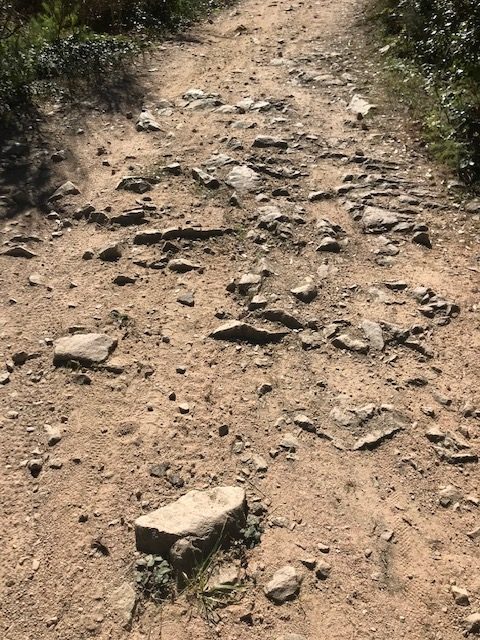
Walking the 10km to the van stop, I had ample time to think about the Schwalbe G-One Bites and their unsuitability to the ride at hand. They look great on paper, but in reality, they are too fragile and prone to punctures and tears for me to add them to my own bike. I was also able to consider the application of 33mm valve stems in 30mm deep rims and how that combo is less than functional.
The Shimano Ultegra grouppo is fine. Shimano makes nice stuff, but the compact 50-34 chainrings have no business on a gravel bike. The ginormous Japanese component maker needs to embrace 46-30 for gravel. Like SRAM has, for example. Or FSA. Or Race Face. Or any other crank manufacturer. If you buy a Grail, just pull those cranks off and put them on eBay so they’ll end up on a road bike, where they belong. The repeated 20-25% ramps we’ve ridden on this gravel trip have proven that a 34-32 is just not low enough.
Remember that bigger tires means larger circumferences, so a 38c tire is taller-geared than a 25. As the tire size increases, you are turning more gear-inches, so it’s a good idea to adjust gear ratios to compensate. Gravel roads tend towards the steep, and the tires basically make the cassette smaller, so Shimano’s lack of sub compact cranksets makes climbing pretty burly, particularly with the stock 11-32 cassette. Keep in mind, they were very resistant to DuraAce compact cranksets for a long time as well.
I’ve become accustomed to the Di-2 shifting, and it’s possible that it’s in some sort of special mode, but I can’t actually shift across the entire 11-speed cassette: no 34-11 for me. Now, I’ve been at this long enough that I never cross-chain, but this is a rental, and thus I don’t care. The Big S says NO, however. I’m looking forward to getting back on my bike at home and my muscle-memory-trained SRAM shifting. Still, the Di-2 is nice. Not world-changing, not mind-blowing, but nice. (Note: later in the trip I rented a road bike with mechanical 11-speed DoyouRace, and I liked the mechanical shifting much more than the Ultegra Di-2. I was able to cross-chain to my heart’s content with mechanical, and that grouppo shifts beautifully).
Looking at Canyon’s site, they show the 2XS frame to be suitable for someone 156cm tall. This is around 5’2”, so if you are a diminutive rider, look elsewhere. My medium seems to fit reasonably well, but not as perfect as my custom 56.5 (ETT) gravel bike that my wife does not know about. If I had such a bike, it would have FSA K-Wing bars, which have a very nice flex regardless of hand placement, as the flats allow the whole bar to flex. FSA has introduced a gravel version of the Metron 4D bar, which I hope to try on my gravel bike.
That is, if I had one, which I don’t. Really. Just stay out of the basement, dear. There are spiders down there. Big ones. With fangs.
My inseam is not long (30”), and I find the standover of this bike to be entering the lift-and-separate realm. In order to put one foot down, I have to lean the bike slightly. In most instances, this is no big deal, but stepping off the downhill side on singletrack could lead to me swearing in a much higher octave than normal.
I’m about 180cm tall, so according to Canyon I should be on a medium. 2 other guys on the trip who are effectively my height were on small frames, so there’s a bit of grey to the fit recommendations. Canyon has a fit calculator on their site, so that’s probably the best place to start.
Canyon provides 650b wheels with the 2XS and XS frames, but 700c wheels with all the other sizes. Having ridden both wheel sizes in gravel for the last couple of years, I am a huge fan of 650b x 50 tires for gravel. The wider tire allows better grip, reduced pressures, more comfort, and better rolling than the nominal 700 x 38. It’s hard to guess how large a 650b tire would fit in the 700c frames, but during this ride, I missed my 650s.
I “interviewed” (read as: pestered) two other guests for their take on the bike. One said he thought it was great, I asked why, and he couldn’t answer. He is the type who hops on a bike, and if it rolls, it must be good. The other guy loved the bike, and he doesn’t mind the proprietary stem and bar combo. As he owns a Canyon road bike, he is already a fan and liked the Grail.
Both are MAMILs, and they are more typical of how people react to questions about a bike: yeah, it’s good. Neither are the type to dig deep into geometry, but both are very strong riders who appreciate a good machine.
Overall, I would say that the Canyon Grail has some very clever and creative ideas, rides well, and is a nice gravel bike. If you have the budget and are gravel-curious, by all means put this high on your list. If you’ve ridden gravel bikes and are starting to understand what you do and do not like, or if you like to change and dial in your bike with different components, this may not be the best option, mainly because it’s not easy to customize.
My complaints are minor, and I have enjoyed the bike. I prefer my own (non-existent) bike since it fits me better and has a wheelset I like more, plus I am happier with SRAM shifting. However, that being said, the Grail is a capable gravel machine. It’s predictable, stable, planted, perhaps could be livelier, but it’s good. It’s just not amazing.
